Feifei Gao
Sherman
Corrections to "Computer Vision Aided mmWave Beam Alignment in V2X Communications"
Oct 08, 2024



Abstract:In this document, we revise the results of [1] based on more reasonable assumptions regarding data shuffling and parameter setup of deep neural networks (DNNs). Thus, the simulation results can now more reasonably demonstrate the performance of both the proposed and compared beam alignment methods. We revise the simulation steps and make moderate modifications to the design of the vehicle distribution feature (VDF) for the proposed vision based beam alignment when the MS location is available (VBALA). Specifically, we replace the 2D grids of the VDF with 3D grids and utilize the vehicle locations to expand the dimensions of the VDF. Then, we revise the simulation results of Fig. 11, Fig. 12, Fig. 13, Fig. 14, and Fig. 15 in [1] to reaffirm the validity of the conclusions.
Electromagnetic Property Sensing and Channel Reconstruction Based on Diffusion Schrödinger Bridge in ISAC
Sep 18, 2024Abstract:Integrated sensing and communications (ISAC) has emerged as a transformative paradigm for next-generation wireless systems. In this paper, we present a novel ISAC scheme that leverages the diffusion Schrodinger bridge (DSB) to realize the sensing of electromagnetic (EM) property of a target as well as the reconstruction of the wireless channel. The DSB framework connects EM property sensing and channel reconstruction by establishing a bidirectional process: the forward process transforms the distribution of EM property into the channel distribution, while the reverse process reconstructs the EM property from the channel. To handle the difference in dimensionality between the high-dimensional sensing channel and the lower-dimensional EM property, we generate latent representations using an autoencoder network. The autoencoder compresses the sensing channel into a latent space that retains essential features, which incorporates positional embeddings to process spatial context. The simulation results demonstrate the effectiveness of the proposed DSB framework, which achieves superior reconstruction of the targets shape, relative permittivity, and conductivity. Moreover, the proposed method can also realize high-fidelity channel reconstruction given the EM property of the target. The dual capability of accurately sensing the EM property and reconstructing the channel across various positions within the sensing area underscores the versatility and potential of the proposed approach for broad application in future ISAC systems.
6D Motion Parameters Estimation in Monostatic Integrated Sensing and Communications System
Jul 11, 2024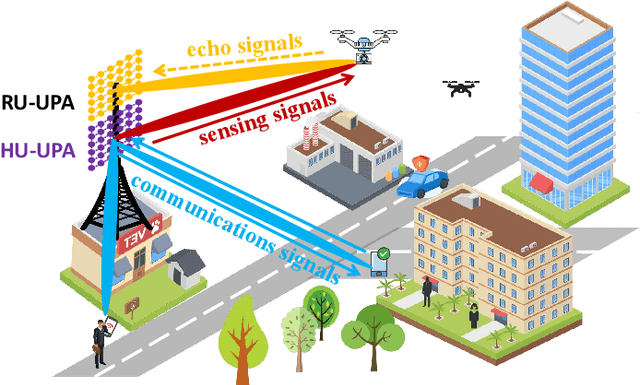
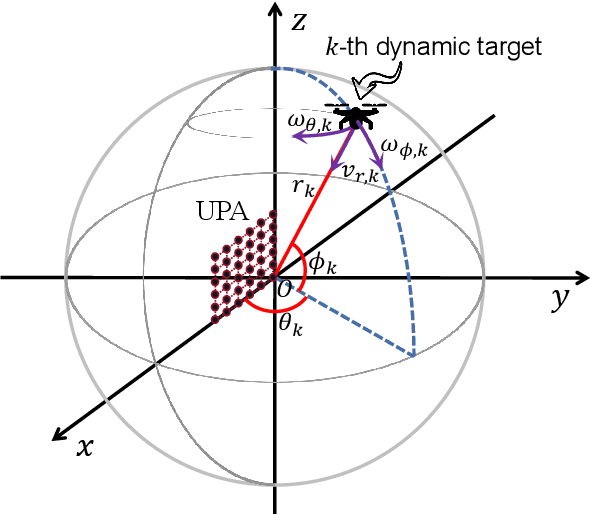
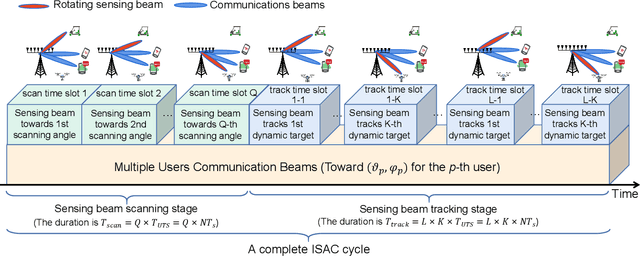
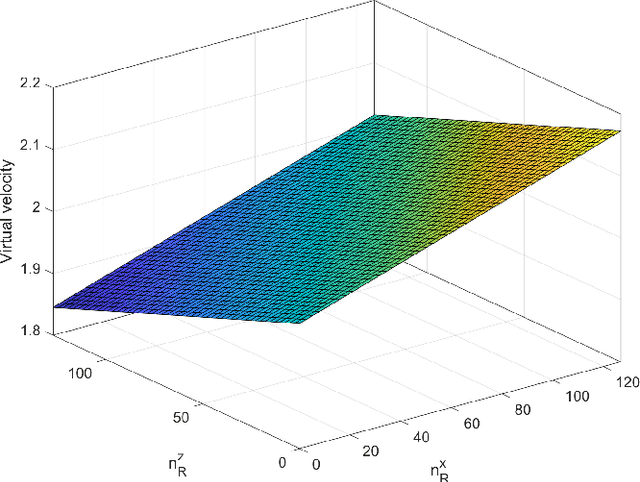
Abstract:In this paper, we propose a novel scheme to estimate the six dimensional (6D) motion parameters of dynamic target for monostatic integrated sensing and communications (ISAC) system. We first provide a generic ISAC framework for dynamic target sensing based on massive multiple input and multiple output (MIMO) array. Next, we derive the relationship between the sensing channel of ISAC base station (BS) and the 6D motion parameters of dynamic target. Then, we employ the array signal processing methods to estimate the horizontal angle, pitch angle, distance, and virtual velocity of dynamic target. Since the virtual velocities observed by different antennas are different, we adopt plane fitting to estimate the dynamic target's radial velocity, horizontal angular velocity, and pitch angular velocity from these virtual velocities. Simulation results demonstrate the effectiveness of the proposed 6D motion parameters estimation scheme, which also confirms a new finding that one single BS with massive MIMO array is capable of estimating the horizontal angular velocity and pitch angular velocity of dynamic target.
OFDM Achieves the Lowest Ranging Sidelobe Under Random ISAC Signaling
Jul 09, 2024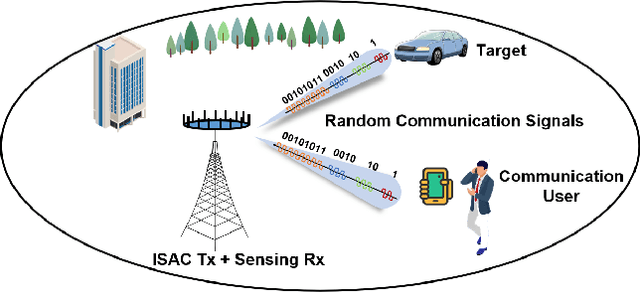
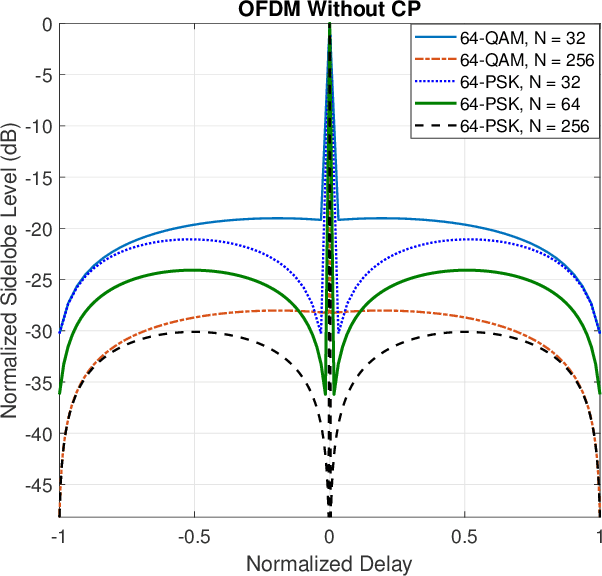
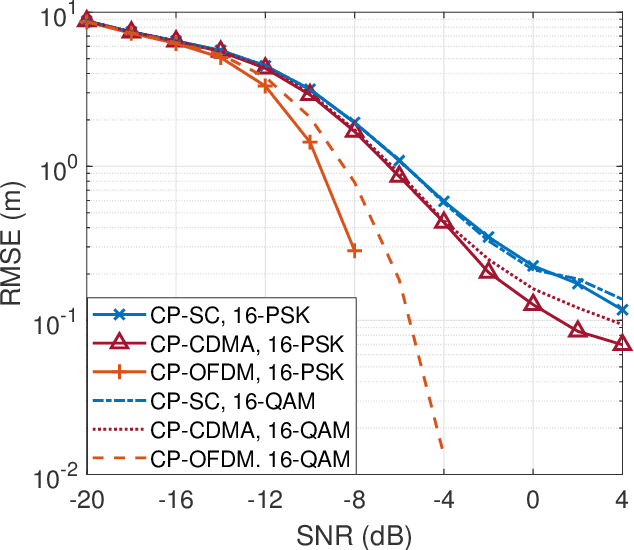
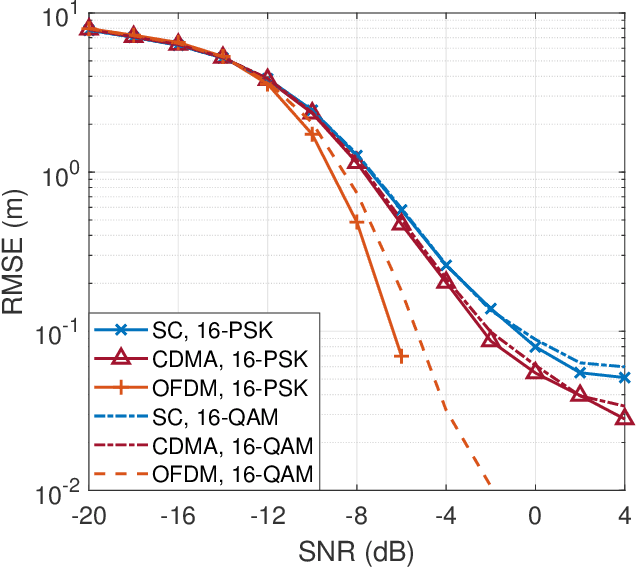
Abstract:This paper aims to answer a fundamental question in the area of Integrated Sensing and Communications (ISAC): What is the optimal communication-centric ISAC waveform for ranging? Towards that end, we first established a generic framework to analyze the sensing performance of communication-centric ISAC waveforms built upon orthonormal signaling bases and random data symbols. Then, we evaluated their ranging performance by adopting both the periodic and aperiodic auto-correlation functions (P-ACF and A-ACF), and defined the expectation of the integrated sidelobe level (EISL) as a sensing performance metric. On top of that, we proved that among all communication waveforms with cyclic prefix (CP), the orthogonal frequency division multiplexing (OFDM) modulation is the only globally optimal waveform that achieves the lowest ranging sidelobe for quadrature amplitude modulation (QAM) and phase shift keying (PSK) constellations, in terms of both the EISL and the sidelobe level at each individual lag of the P-ACF. As a step forward, we proved that among all communication waveforms without CP, OFDM is a locally optimal waveform for QAM/PSK in the sense that it achieves a local minimum of the EISL of the A-ACF. Finally, we demonstrated by numerical results that under QAM/PSK constellations, there is no other orthogonal communication-centric waveform that achieves a lower ranging sidelobe level than that of the OFDM, in terms of both P-ACF and A-ACF cases.
Electromagnetic Property Sensing Based on Diffusion Model in ISAC System
Jul 03, 2024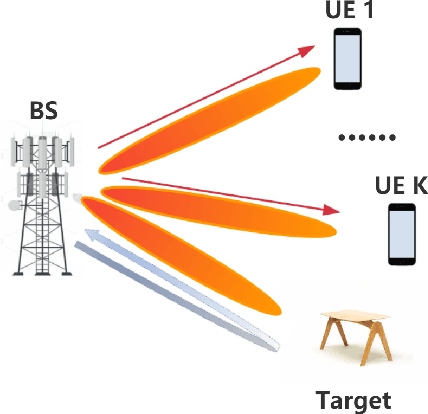
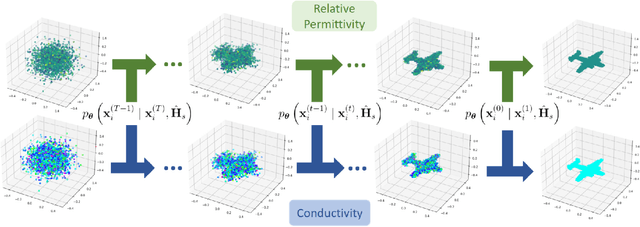
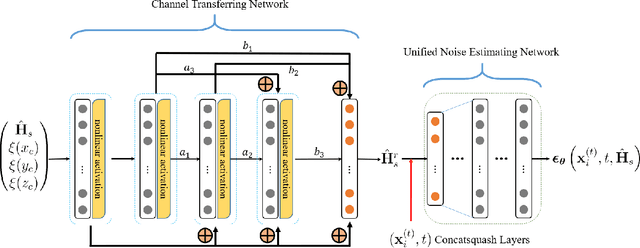
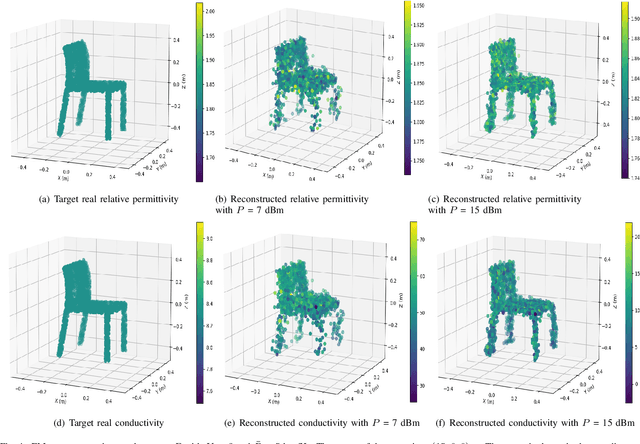
Abstract:Integrated sensing and communications (ISAC) has opened up numerous game-changing opportunities for future wireless systems. In this paper, we develop a novel ISAC scheme that utilizes the diffusion model to sense the electromagnetic (EM) property of the target in a predetermined sensing area. Specifically, we first estimate the sensing channel by using both the communications and the sensing signals echoed back from the target. Then we employ the diffusion model to generate the point cloud that represents the target and thus enables 3D visualization of the target's EM property distribution. In order to minimize the mean Chamfer distance (MCD) between the ground truth and the estimated point clouds, we further design the communications and sensing beamforming matrices under the constraint of a maximum transmit power and a minimum communications achievable rate for each user equipment (UE). Simulation results demonstrate the efficacy of the proposed method in achieving high-quality reconstruction of the target's shape, relative permittivity, and conductivity. Besides, the proposed method can sense the EM property of the target effectively in any position of the sensing area.
Low-Overhead Channel Estimation via 3D Extrapolation for TDD mmWave Massive MIMO Systems Under High-Mobility Scenarios
Jun 13, 2024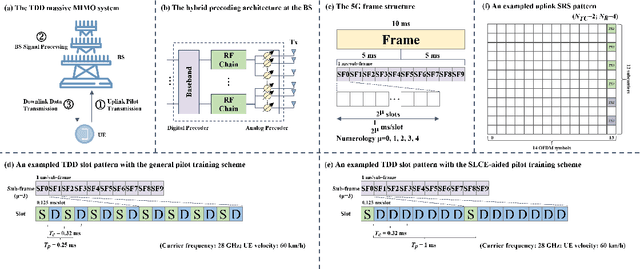
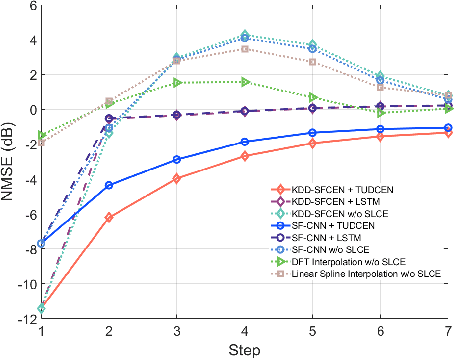
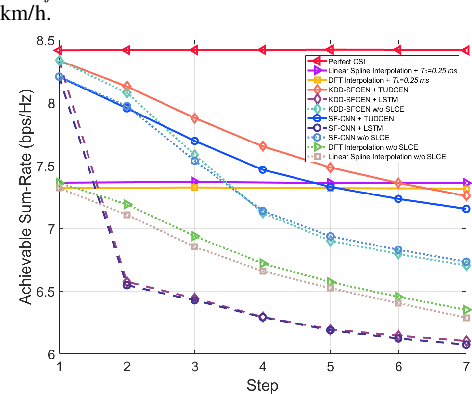
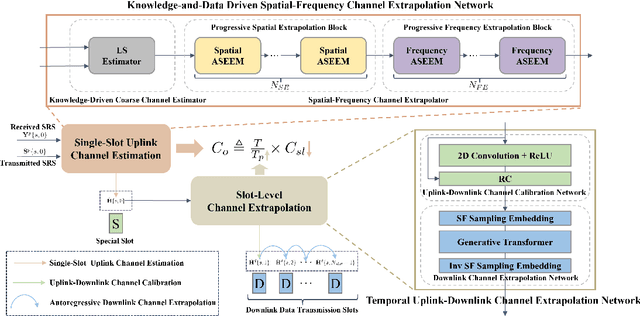
Abstract:In TDD mmWave massive MIMO systems, the downlink CSI can be attained through uplink channel estimation thanks to the uplink-downlink channel reciprocity. However, the channel aging issue is significant under high-mobility scenarios and thus necessitates frequent uplink channel estimation. In addition, large amounts of antennas and subcarriers lead to high-dimensional CSI matrices, aggravating the pilot training overhead. To systematically reduce the pilot overhead, a spatial, frequency, and temporal domain (3D) channel extrapolation framework is proposed in this paper. Considering the marginal effects of pilots in the spatial and frequency domains and the effectiveness of traditional knowledge-driven channel estimation methods, we first propose a knowledge-and-data driven spatial-frequency channel extrapolation network (KDD-SFCEN) for uplink channel estimation by exploiting the least square estimator for coarse channel estimation and joint spatial-frequency channel extrapolation to reduce the spatial-frequency domain pilot overhead. Then, resorting to the uplink-downlink channel reciprocity and temporal domain dependencies of downlink channels, a temporal uplink-downlink channel extrapolation network (TUDCEN) is proposed for slot-level channel extrapolation, aiming to enlarge the pilot signal period and thus reduce the temporal domain pilot overhead under high-mobility scenarios. Specifically, we propose the spatial-frequency sampling embedding module to reduce the representation dimension and consequent computational complexity, and we propose to exploit the autoregressive generative Transformer for generating downlink channels autoregressively. Numerical results demonstrate the superiority of the proposed framework in significantly reducing the pilot training overhead by more than 16 times and improving the system's spectral efficiency under high-mobility scenarios.
Integrated Sensing and Communications Framework for 6G Networks
May 30, 2024



Abstract:In this paper, we propose a novel integrated sensing and communications (ISAC) framework for the sixth generation (6G) mobile networks, in which we decompose the real physical world into static environment, dynamic targets, and various object materials. The ubiquitous static environment occupies the vast majority of the physical world, for which we design static environment reconstruction (SER) scheme to obtain the layout and point cloud information of static buildings. The dynamic targets floating in static environments create the spatiotemporal transition of the physical world, for which we design comprehensive dynamic target sensing (DTS) scheme to detect, estimate, track, image and recognize the dynamic targets in real-time. The object materials enrich the electromagnetic laws of the physical world, for which we develop object material recognition (OMR) scheme to estimate the electromagnetic coefficient of the objects. Besides, to integrate these sensing functions into existing communications systems, we discuss the interference issues and corresponding solutions for ISAC cellular networks. Furthermore, we develop an ISAC hardware prototype platform that can reconstruct the environmental maps and sense the dynamic targets while maintaining communications services. With all these designs, the proposed ISAC framework can support multifarious emerging applications, such as digital twins, low altitude economy, internet of vehicles, marine management, deformation monitoring, etc.
Environment Sensing-aided Beam Prediction with Transfer Learning for Smart Factory
May 24, 2024Abstract:In this paper, we propose an environment sensing-aided beam prediction model for smart factory that can be transferred from given environments to a new environment. In particular, we first design a pre-training model that predicts the optimal beam by sensing the present environmental information. When encountering a new environment, it generally requires collecting a large amount of new training data to retrain the model, whose cost severely impedes the application of the designed pre-training model. Therefore, we next design a transfer learning strategy that fine-tunes the pre-trained model by limited labeled data of the new environment. Simulation results show that when the pre-trained model is fine-tuned by 30\% of labeled data from the new environment, the Top-10 beam prediction accuracy reaches 94\%. Moreover, compared with the way to completely re-training the prediction model, the amount of training data and the time cost of the proposed transfer learning strategy reduce 70\% and 75\% respectively.
Electromagnetic Property Sensing in ISAC with Multiple Base Stations: Algorithm, Pilot Design,and Performance Analysis
May 10, 2024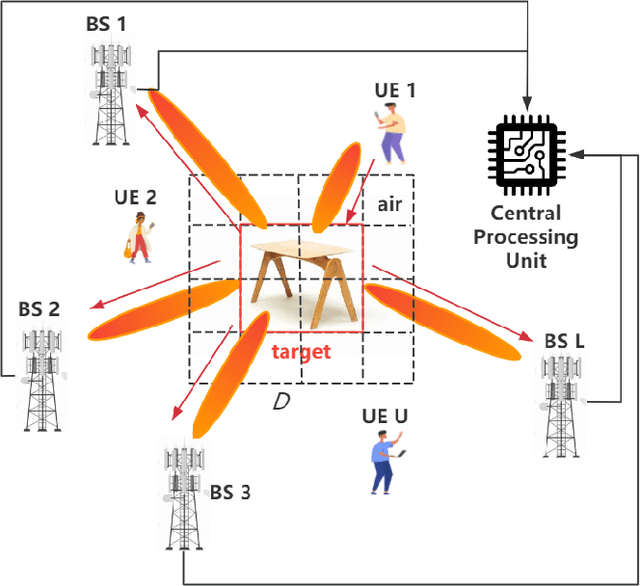
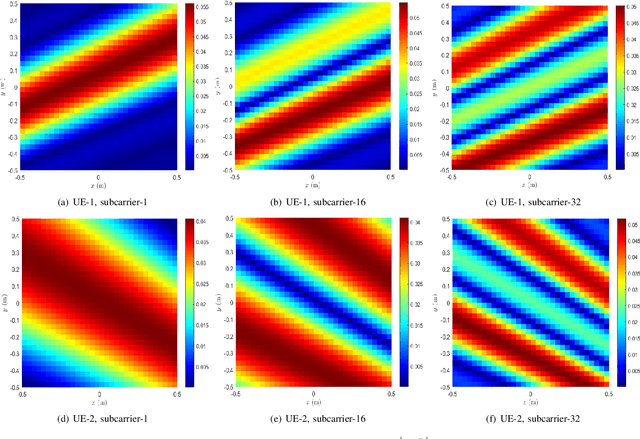
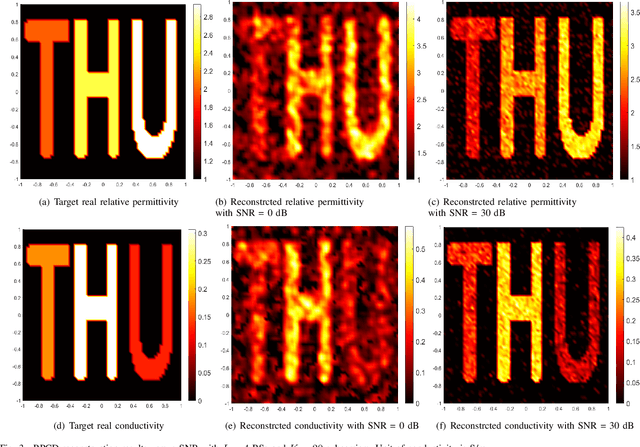
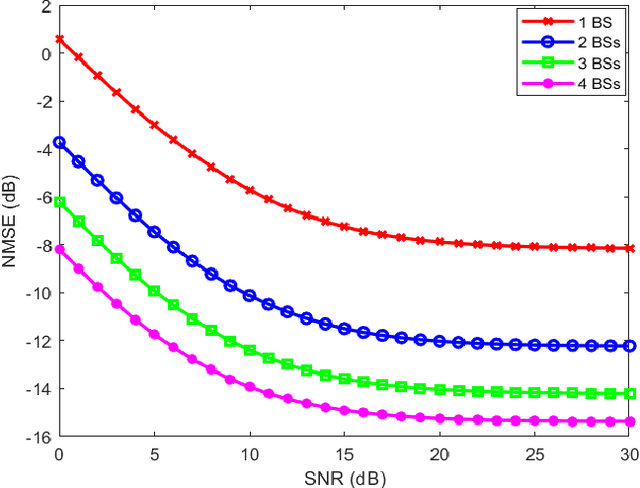
Abstract:Integrated sensing and communication (ISAC) has opened up numerous game-changing opportunities for future wireless systems. In this paper, we develop a novel scheme that utilizes orthogonal frequency division multiplexing (OFDM) pilot signals to sense the electromagnetic (EM) property of the target and thus identify the materials of the target. Specifically, we first establish an EM wave propagation model with Maxwell equations, where the EM property of the target is captured by a closed-form expression of the channel. We then build the mathematical model for the relative permittivity and conductivity distribution (RPCD) within a predetermined region of interest shared by multiple base stations (BSs). Based on the EM wave propagation model, we propose an EM property sensing method, in which the RPCD can be reconstructed from compressive sensing techniques that exploits the joint sparsity structure of the EM property vector. We then develop a fusion algorithm to combine data from multiple BSs, which can enhance the reconstruction accuracy of EM property by efficiently integrating diverse measurements. Moreover, the fusion is performed at the feature level of RPCD and features low transmission overhead. We further design the pilot signals that can minimize the mutual coherence of the equivalent channels and enhance the diversity of incident EM wave patterns. Simulation results demonstrate the efficacy of the proposed method in achieving high-quality RPCD reconstruction and accurate material classification.
Environment Reconstruction based on Multi-User Selection and Multi-Modal Fusion in ISAC
Mar 26, 2024



Abstract:Integrated sensing and communications (ISAC) has been deemed as a key technology for the sixth generation (6G) wireless communications systems. In this paper, we explore the inherent clustered nature of wireless users and design a multi-user based environment reconstruction scheme. Specifically, we first select users based on the estimation precision of channel's multipath, including the line-of-sight (LOS) and the non-line-of-sight (NLOS) paths, to enhance the accuracy of environment reconstruction. Then, we develop a fusion strategy that merges communications signalling with camera image to increase the accuracy and robustness of environment reconstruction. The simulation results demonstrate that the proposed algorithm can achieve a remarkable sensing accuracy of centimeter level, which is about 17 times better than the scheme without user selection. Meanwhile, the fusion of communications data and vision data leads to a threefold accuracy improvement over the image only method, especially under challenging weather conditions like raining and snowing.
 Add to Chrome
Add to Chrome Add to Firefox
Add to Firefox Add to Edge
Add to Edge